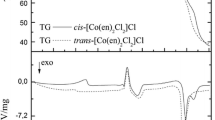Abstract
Liquids trapped in the pores of certain silicate glasses (such as Corning Vycor ‘thirsty’ glass) were found to display frozen solutions like behavior at temperatures much higher than their actual freezing point. For example, recoilless γ-resonance absorption was observed for Mössbauer active solutes such as 119Sn and 57Fe salts at room temperature (i.e., without the need of quenching). Thus capillary Mössbauer spectroscopy (CMS) proved to be a new and useful experimental tool with great potential in solution chemistry. As part of a research project concerned with the hydrolysis of SnII salts, we attempted to perform 119Sn CMS measurements for solutions containing stannous ion in a range of aqueous environments. Somewhat surprisingly, we found that under ambient conditions, SnII aqueous liquid solutions, both the acidic and the basic systems, are essentially CMS-silent. This can be attributed to the strong temperature dependence of Lamb–Mössbauer factor of SnII species, which may result in the complete disappearance of Mössbauer pattern well below room temperature. These observations can also explain why previous publications concerned with the use of CMS dealt exclusively with SnIV and not with SnII containing liquids.








Similar content being viewed by others
Notes
The ‘thirsty’ glasses was kindly donated to us by the late Prof. Attila Vértes.
References
Mössbauer RL (1958) Kernresonazfluoreszenz von Gammastrahlung in 191Ir. Z Phys 151(2):124–143
Vértes A, Nagy DL (1990) Mössbauer spectroscopy of frozen solutions. Akadémiai Kiadó, Budapest
Burger K, Vértes A (1983) Capillary Mössbauer spectroscopy for solution chemistry. Nature 306(24):353–354
Burger K, Vértes A, Zay I (1983) Capillary Mössbauer spectroscopy (CMS). The study of liquid samples trapped in the pores of thirsty glass. Inorg Chim Acta 76(4):L247–L250
Burger K (1987) Capillary Mössbauer spectroscopy (CMS)—a new method for the study of liquids fixed in a suitable carrier. Spectrochim Acta 43A(9):1105–1110
Burger K, Vértes A, Suba M, Dékány I (1985) Mössbauer spectroscopy of SnCl4 solutions trapped in the pores of ‘thirsty glass’ carrier. Inorg Chim Acta 100(1):17–21
Schwertz FA (1949) Fluid flow study of porous glass. J Am Ceram Soc 32(12):390–393
Burger K, Nemes-Vetéssy ZS, Vértes A, Suba M, Knausz D (1988) Influence of the nature of the solute and the carrier surface on the Mössbauer effect in aqueous solutions trapped in a silicate carrier. Inorg Chim Acta 148(2):223–226
Vértes A (1990) Mössbauer spectra recorded in frozen solutions. In: Vértes A, Nagy DL (eds) Mössbauer spectroscopy of frozen solutions. Akadémiai Kiadó, Budapest, pp 60–70
Stevens JG (ed) Mössbauer Effect Data Journal. Mössbauer Effect Data Center, Asheville. 1975–2006
Sipos P, Hefter G, May PM (2000) Viscosities and densities of highly concentrated aqueous MOH solutions (M+ = Na+, K+, Li+, Cs+, (CH3)4N+) at 25.0 °C. J Chem Eng Data 45(4):613–617
Sipos P, May PM, Hefter G (2000) Carbonate removal from concentrated hydroxide solutions. The Analyst 125(5):955–958
Tobias RS (1958) Studies on the hydrolysis of metal ions. 21. The hydrolysis of the tin(II) ion, Sn2+. Acta Chem Scand 12(2):198–223
Gajda T, Sipos P, Gamsjager H (2009) The standard electrode potential of the Sn4+/Sn2+ couple revisited. Moantsch Chem 140(10):1293–1303
http://www.corning.com/docs/specialtymaterials/pisheets/Vycor%207930.pdf (last visit: 10/03/2014)
Klencsár Z, Kuzmann E, Vértes A (1996) User-friendly software for Mössbauer-spectrum. Anal J Radioanal Nucl Chem 210(1):105–114
Sherman DM, Ragnarsdottir KV, Oelkers EH, Collins CR (2000) Speciation of tin (Sn2+ and Sn4+) in aqueous Cl solutions from 25 to 350 °C: an in situ EXAFS study. Chem Geol 167(2):169–176
Acknowledgments
This research was supported by grants of the Hungarian Science Foundation (OTKA K83889 and K111692). The support is highly appreciated. The Authors wish to thank Ilona Halasi for her valuable assistance in the experimental work.
Author information
Authors and Affiliations
Corresponding author
Additional information
The authors wish to dedicate this paper to the memory of Prof. Attila Vértes (1934–2011).
Rights and permissions
About this article
Cite this article
Bajnóczi, É.G., Bohner, B., Czeglédi, E. et al. On the lack of capillary Mössbauer spectroscopic effect for SnII-containing aqueous solutions trapped in corning Vycor ‘thirsty’ glass. J Radioanal Nucl Chem 302, 695–700 (2014). https://doi.org/10.1007/s10967-014-3247-2
Received:
Published:
Issue Date:
DOI: https://doi.org/10.1007/s10967-014-3247-2




